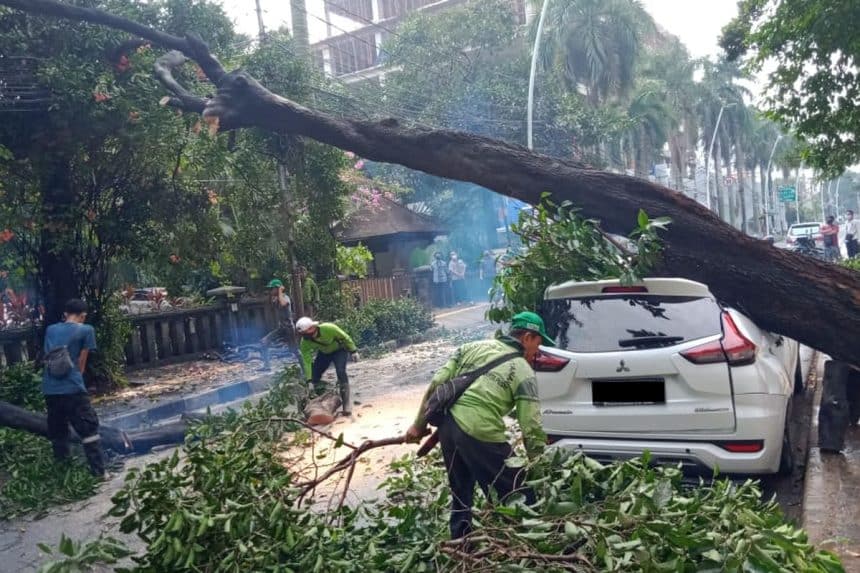The dynamics of the Indonesian insurance industry are entering a challenging period towards the end of 2025. From slowing premium growth, soaring medical costs, changing consumer behavior, rising demand for sharia-compliant insurance, to pressures from capital regulations—all these factors point to an increasingly complex risk landscape in the national financial and protection sector. Furthermore, real-world cases, such as cars damaged by falling trees during extreme weather, also emphasize the importance of policy education for the public, particularly regarding coverage limits and coverage extensions. In this report, we summarize seven key developments in the Indonesian insurance industry, while also providing a risk perspective, business implications, and the urgency of strengthening risk management for both companies and individuals.
General Insurance Premiums Slow! AAUI Reveals Why 2025 Target Was Not Achieved
The Indonesian general insurance industry recorded premium revenue of Rp 84.77 trillion through the third quarter of 2025, representing a 6.3% growth. While positive, this figure is well below the initial year’s projected 8%–10% target. AAUI Chairman Budi Herawan emphasized that this realization fell short of expectations, especially compared to last year’s 18% growth.
The outlook for the end of the year remains difficult to predict due to the many economic indicators and risks that influence industry performance.
AAUI identified three main business lines as supporting premium growth:
- Property insurance rose by Rp 1.27 trillion
- Health insurance rises by Rp 1.055 trillion
- Credit insurance rose by Rp 1.278 trillion
In terms of composition, property insurance is the largest contributor with a share of 29.2%, followed by motor vehicles at 16.7%, credit insurance at 16%, and health at 9.5%.
However, several lines continued to depress overall growth. Motor vehicle premiums fell 4%, while credit insurance premiums rose only moderately, at 5.4%.
On the claims side, the industry paid out Rp 35.03 trillion, a 4.9% increase from last year. The largest claims came from credit insurance (Rp 11.89 trillion) and health insurance (Rp 6.38 trillion), both of which experienced significant growth.
Slowing premium growth and rising claims represent a serious challenge for the general insurance industry heading into the end of 2025.
Despite a Decline in International Tourism, Travel Insurance Purchases Have Exploded 400%! What’s Happening to Indonesian Tourists?
Oona Insurance Indonesia recorded a more than 400% surge in international travel insurance purchases from January to October 2025. Ironically, this increase occurred while the number of Indonesian tourists traveling abroad actually decreased by 5.24%, according to Statistics Indonesia (BPS) data. This phenomenon demonstrates a shift in consumer behavior: traveling without protection is now considered too risky.
The surge in demand is largely driven by year-end holiday plans, increased awareness of travel risks, and the need for more comprehensive protection. Travelers are no longer seeking the cheapest policies, but instead opting for benefits that cover emergency medical expenses, flight delays, lost baggage, and trip cancellations.
Schengen countries, Japan, Singapore, and Malaysia were the destinations with the highest contributions. Oona’s partnership with VFS Global also contributed to the increase in sales, as visa applicants can purchase insurance directly at the Schengen visa application center.
Oona also adapts their products for domestic and international travel, following increasingly diverse consumer preferences.
Oona Insurance Indonesia’s Chief Marketing Officer, Prashant Shetty, emphasized the company’s commitment to helping people travel with more confidence. “We want customers to focus on experiences, not worries,” he said.
Source: https://wartaekonomi.co.id/read590840/oona-catat-lonjakan-asuransi-perjalanan-hingga-400
Sharia Insurance is Booming! Why Are So Many Indonesians Turning to Mutual Assistance-Based Protection?
Sharia-compliant general insurance is increasingly becoming a popular choice for Indonesians, especially amidst life’s uncertainties and the growing need for asset protection. With a Muslim population of 87%, or 229.62 million, demand for Sharia-compliant insurance products continues to rise. By the first quarter of 2025, Sharia insurance premiums accounted for 8.45% of total industry premiums, demonstrating significant year-over-year growth.
Unlike conventional systems, Sharia insurance is based on the values of mutual assistance and risk sharing, not risk transfer. This system is regulated by DSN-MUI Fatwa No. 21/2021 and Law No. 40/2014, ensuring fund management is free from elements of maysir, gharar, and usury. Participants set aside a portion of their contributions to the Tabarru’ Fund, which is used to help other participants in times of disaster—a tangible manifestation of financial solidarity.
Interestingly, Sharia insurance is universal, meaning it can be purchased by anyone, including non-Muslims. This product is suitable for individuals seeking to protect their family, assets, or businesses in an ethical and transparent manner.
To obtain maximum benefits, prospective participants need to understand their protection needs, adjust premiums to their budget, choose a reputable company, and thoroughly read the policy. With its ethical and community-based approach, Sharia insurance is believed to be a protection solution that is not only safe but also brings blessings.
Insurance Industry Threatened by 2026? AAUI Urges OJK to Delay Minimum Capital Increase!
The Indonesian General Insurance Association (AAUI) has officially requested that the Financial Services Authority (OJK) grant a timeframe for meeting the minimum capital requirements for insurance and reinsurance companies in accordance with POJK 23/2023, which will take effect in 2026. The request was submitted through a letter containing an academic study presented at the 2025 Indonesia Rendezvous event.
AAUI Chairman Budi Herawan explained that the request was not an attempt to reject the regulation, but rather a request for an extension because the current industry is not yet fully prepared. AAUI’s mapping shows that approximately 5–10 member companies have not yet reached the minimum equity requirement.
AAUI also partnered with two other associations—AAJI and AASI—to compile a similar study. Budi emphasized that companies must continue to strengthen business fundamentals, such as implementing efficiency measures and evaluating portfolios, while awaiting an official response from the OJK.
On the other hand, the Financial Services Authority (OJK) confirmed that there are no plans to provide any relaxation. The Chief Executive of the PPDP Supervisory Agency (PPDP), Ogi Prastomiyono, emphasized that this regulation is crucial for strengthening the financial health and resilience of the industry. To date, the OJK remains committed to consistently implementing capital policies without delay.
Car Hit by a Tree During Rain? Be Careful, Your Insurance Claim Could Be Rejected! Here’s the Full Explanation
Another fallen tree incident occurred in Jakarta. A Toyota Calya was severely damaged after being struck by a falling tree at around 11:00 a.m. Western Indonesian Time (WIB) on Thursday (November 20, 2025), as reported by the Jakarta Metropolitan Police’s Traffic Management Unit (TMC). Recent extreme weather—heavy rain and strong winds—has increased the risk of road accidents. However, the question is: can damage caused by fallen trees be claimed through insurance?
Laurentius Iwan Pranoto, Head of Public Relations at Asuransi Astra, explained that natural disasters are difficult to predict. Therefore, it’s crucial for vehicle owners to have the right protection. However, many car owners don’t realize that standard vehicle insurance policies don’t cover damage caused by natural disasters.
According to Article 3, paragraph 3.2 of the Indonesian Financial Accounting Standards Act (PSAKBI), damage caused by natural disasters—including fallen trees—falls within the coverage exceptions. This means that claims cannot be processed if the owner only has a standard policy without extended coverage.
New claims can only be accepted if the owner has added disaster coverage to the policy from the outset. If the coverage is purchased after the incident, the claim will automatically be rejected.
This incident is an important reminder for car owners to ensure their policy includes comprehensive protection, especially during the rainy season.
Global Medical Costs to Explode by 2026! Asia Pacific Leads, Indonesia Falls — What’s Going On?
Willis Towers Watson (WTW) projects global medical costs will surge again in 2026, reaching a 10.3% increase, continuing the trend of healthcare inflation that is pressuring the insurance industry and companies worldwide. Asia Pacific is the region with the highest increase, predicted to reach 14%, surpassing Latin America, the Middle East & Africa, North America, and Europe.
Report 2026 Global Medical Trends SurveyResearch shows that more than half of global insurers anticipated this increase, and another 55% expect the medical inflation trend to persist over the next three years. Key factors driving medical inflation include new medical technologies, declining public healthcare services, soaring pharmaceutical costs, and fraudulent and wasteful practices within the healthcare system.
While other regions experienced increases, Indonesia actually showed improvement. National medical inflation is projected to decline to 12.9% in 2026 from a surge of 16.9% in 2025. This decline is driven by improvements in the claims ratio and tariff reviews by insurance companies throughout 2024. However, significant challenges remain, particularly as 90% of pharmaceutical raw materials are still dependent on imports.
OJK is now preparing new regulations, including a mandatecost sharing, to prevent the collapse of insurance companies and maintain premium stability.
Life Insurance Premiums Plummet for 3 Consecutive Months! Public Confidence Collapses, Threatening Industry Contraction Until 2026
The life insurance industry is once again under severe pressure due to the loss of public trust following a series of unresolved default cases, from Jiwasraya, Bumiputera, Kresna Life to WanaArtha.scarring effectmaking people increasingly reluctant to buy protection products, especially unit-linked products which are the most affected.
Wahju Rohmanti, a lecturer in Islamic insurance at UIN Banten, believes that without a strategy to restore trust and modernize marketing, the industry will face another premium revenue contraction until the first quarter of 2026. This is evident from OJK data, which shows life insurance premiums declining for three consecutive months: -0.84% year-on-year in July, -1.21% in August, and -2.06% in September, to Rp132.85 trillion.
According to Wahju, insurance’s position as a tertiary need has led people to hold off on purchasing it, with the exception of travel insurance, which typically increases at the end of the year. However, insurance analyst Dedy Kristianto offers a slightly more optimistic outlook, with the potential for a moderate rebound in the fourth quarter of 2025 due to seasonal factors.
Dedy suggested four strategies to maintain industry growth: offering affordable premiums, improving protection education, strengthening digital channels and bancassurance, and simplifying products for ease of understanding. Without concrete steps, the life insurance industry is at risk of falling further behind amidst tight economic conditions and low risk appetite.
—
This series of news stories demonstrates that the insurance industry is navigating two major pressures: rising risks and declining market absorption. Premiums are slowing, claims are rising, medical costs are soaring, while public trust—particularly in the life insurance sector—remains fragile. However, behind these challenges lie significant opportunities, ranging from surging demand for travel insurance, the growth of sharia insurance, to the need for protection for vehicles and property from extreme weather. Moving forward, insurance companies need to strengthen their business foundations through product innovation, public education, operational efficiency, and collaboration with regulators. For the public and businesses, understanding risk and selecting the right protection is not only a financial necessity but also a sustainability strategy. With more mature risk management, the insurance industry can remain a pillar of stability amidst rapid economic and environmental change.
—
DON’T WASTE YOUR TIME AND SECURE YOUR FINANCIAL AND BUSINESS WITH THE RIGHT INSURANCE.
HOTLINE L&G 24 JAM: 0811-8507-773(CALL – WHATSAPP – SMS)
Website: lngrisk.co.id
Email: halo@lngrisk.co.id
—















